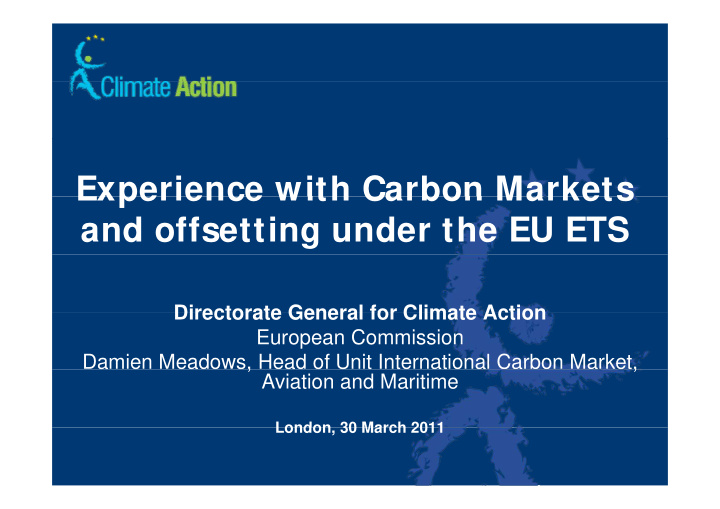



Experience with Carbon Markets Experience with Carbon Markets and offsetting under the EU ETS Directorate General for Climate Action Directorate General for Climate Action European Commission Damien Meadows, Head of Unit International Carbon Market, , , Aviation and Maritime London 30 March 2011 London, 30 March 2011
The EU ETS in brief • Mandatory cap-and-trade system in place since January 2005, now in its seventh year of operation y , y p • Across 30 countries • Covering around half EU GHG emissions (2 bn t) Covering around half EU GHG emissions (2 bn t) • From power generation, steel, cement, chemicals, refineries pulp and paper lime aviation (amongst refineries, pulp and paper, lime, aviation (amongst others) • Essential infrastructure in place: EU allowance • Essential infrastructure in place: EU allowance registry, data management, compliance and enforcement enforcement • Constitutes around 80% of ‘global carbon market’
EU ETS – Carbon Pricing EU ETS – Carbon Pricing EU ETS is majority of International Carbon Market: 87% by Value, 80% by Volume (Source: Bloomberg, New Energy Finance)
EU ETS’s interactions w ith third countries • Linking of emission trading systems foreseen 27 countries initially covered extension to Norway Iceland 27 countries initially covered, extension to Norway, Iceland and Liechtenstein taken place, applicable for Croatia, linking negotiations underway with Switzerland, 2007-2009 g y , • Access for certain international credits Up to half of emission reductions made below 2005 levels Up to half of emission reductions made below 2005 levels Additional access for credits to meet EU Member States’ national reduction targets for 2020 (‘Effort Sharing Decision’) g ( g ) • Use of significant auction revenues to tackle climate change/adaptation including in third countries change/adaptation including in third countries • Sharing ‘lessons learned’ and experience gained
I nternational Credits ( JI / CDM/ sectoral crediting) C / l di i ) • EU ETS provides for companies to use international credits for compliance under EU law: p Up to half of emission reductions made below 2005 levels - under unilateral EU 20% reduction commitment, around 1.7 billion credits) • All JI and CDM credits, subject to standards: All JI d CDM dit bj t t t d d No double-counting No temporary forestry credits (‘lCERs’, ‘tCERs’) No temporary forestry credits ( lCERs , tCERs ) No nuclear credits No HFC or Adipic Acid credits from 2013 onwards • EU law provides for possibility for further measures • And allows for bilateral/ multilateral agreements for ‘sectoral crediting’ (Article 11a(5))
Significant em ission reductions need to be m ade globally EU objective: 80 to 95% reductions largely EU through domestic measures: 100% around -80% internal reductions in 2050 a ou d 80% te a educt o s 050 80% compared to 1990 60% 40% Developed Countries : similar effort p 20% 20% 0% Developing Countries : 1990 2000 2010 2020 2030 2040 2050 Baseline Global action -5% compared to 1990 p Equivalent to - Developed Countries Developing Countries 80% compared 100% 500% to business as 80% 400% usual 60% 300% 40% 200% 20% 100% 0% 0% 0% 1990 2000 2010 2020 2030 2040 2050 1990 2000 2010 2020 2030 2040 2050 Baseline Global action Baseline Global action 6 All sectors need to contribute (or other countries/ sectors do more)
‘Offsetting’ alone cannot solve clim ate change problem li h bl Figure 1: Projected development of greenhouse gas emissions in different regions of the world g 80 ... If EU ETS and other alents OECD countries reduce 70 emissions to zero emissions to zero O2 equiva 60 Rest of World 50 Other annex 1 Other annex 1 40 40 gatonnes C 30 EU 20 Gig ... Global emission path 10 compatible with 2°C 0 scenario 1990 1990 2050 2050 Source: Greenhouse gas reduction pathways in the UNFCCC process up to 2025, CNRS/LEPII-EPE, RIVM/MNP, ICCS-NTUA, CES-KUL (2003).
Mechanism s w ith an ‘ow n contribution‘ are necessary t ib ti ‘ • EU seeking agreement on this evolution through UNFCCC • EU ETS allows for bilateral/ multilateral agreements for ‘sectoral crediting’ (Article 11a(5)) • And provides for transition: Continued access for credits from new CDM projects in Least Developed Countries from 2013 onwards Developed Countries from 2013 onwards And from existing CDM projects in other countries (but not new ones) Once there is an international climate agreement, only credits from countries that have ratified that agreement may be used that provides for companies to use international credits for p p compliance under EU law
A vision: A vision: carbon m arket transition Bilaterally linked cap and trade cap and trade Relative sha Emissions not covered Emissions not covered are of global em by cap and trade missions Sectoral crediting applied Reformed CDM TIME • Increasing focus on LDCs I i f LDC • Strengthen governance • Strengthen environmental integrity
Experience with Carbon Markets Experience with Carbon Markets and offsetting under the EU ETS Directorate General for Climate Action Directorate General for Climate Action European Commission Damien Meadows, Head of Unit International Carbon Market, , , Aviation and Maritime London 30 March 2011 London, 30 March 2011
Recommend
More recommend